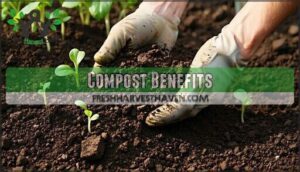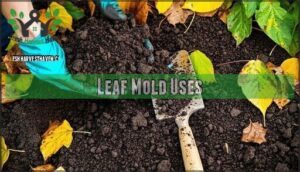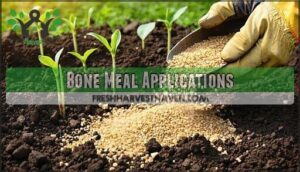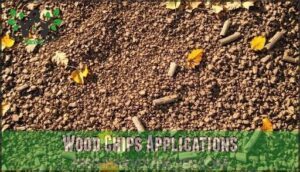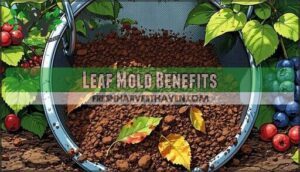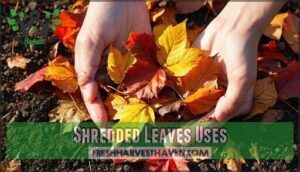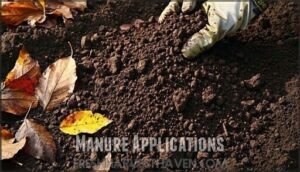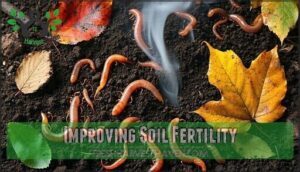This site is supported by our readers. We may earn a commission, at no cost to you, if you purchase through links.
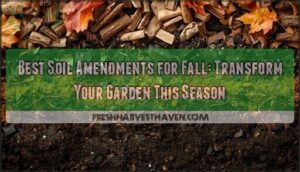 You’ll want to focus on organic amendments that decompose slowly over winter.
You’ll want to focus on organic amendments that decompose slowly over winter.
Compost tops the list as the best soil amendment for fall – it improves structure, adds nutrients, and feeds beneficial microorganisms. Aged manure works similarly, providing steady nutrition without burning plants.
Leaf mold creates excellent soil texture and water retention. Bone meal supplies phosphorus for strong root development, while worm castings offer gentle, slow-release nutrients.
Wood chips make great mulch that eventually breaks down into soil-enhancing organic matter. These amendments work best when mixed into garden beds before winter, giving them months to integrate and transform your soil into a nutrient-rich foundation for spring planting success, using organic matter and slow-release nutrients.
Table Of Contents
- Key Takeaways
- Fall Soil Preparation
- Best Fall Soil Amendments
- Natural Soil Enrichment
- Effective Amendment Strategies
- Improving Soil Fertility
- Frequently Asked Questions (FAQs)
- What should I add to my soil during fall?
- Should you boost your garden soil in the fall?
- How can i Improve my soil in autumn?
- Why should you add organic materials in the fall?
- When is the best time to prepare soil for a garden?
- Why do you need a fall compost application?
- Should you amend soil in the fall?
- How to amend soil between seasons?
- Should you add manure to your garden in the fall?
- What is the best way to amend soil in the fall?
- Conclusion
Key Takeaways
- Add compost and aged manure in fall – Apply 2-4 inches of these slow-release amendments to replenish nutrients depleted from summer growing, giving them months to decompose before spring planting.
- Skip aggressive tilling to protect soil ecosystems – Use hand-digging or broadforking instead to preserve beneficial earthworms and microbial networks that plants depend on for nutrients.
- Layer multiple organic amendments for maximum benefits – Combine carbon-rich materials like shredded leaves with nitrogen sources like worm castings to create an ideal nutrient balance and soil structure.
- Time applications 2-6 weeks before the first freeze – Apply amendments while soil temperatures stay above 50°F so microbes can break down materials effectively through the winter months.
Fall Soil Preparation
Fall is the ideal time to prepare your garden soil because amendments have months to decompose and integrate before spring planting begins.
You’ll want to focus on gentle preparation methods that protect soil structure while removing weeds and adding organic matter.
Reconsidering Tilling
Years of aggressive tilling actually harm your garden more than help.
This practice breaks down soil structure, disturbs beneficial earthworms, and brings dormant weed seeds to the surface.
Tilling also disrupts essential microbial networks that plants depend on for nutrients.
Underground soil networks are your garden’s hidden internet – don’t break the connection.
Instead, consider tilling alternatives like broadforking or adding organic matter directly to preserve your soil’s natural ecosystem.
Hand-Digging for Small Gardens
Hand-digging remains the gold standard for small garden spaces, offering precise control over soil preparation.
Use a spade or fork to loosen compacted soil to eight-inch depths, creating ideal soil aeration. This technique allows careful weed control while preserving beneficial earthworms.
Small spaces benefit from targeted digging techniques that protect existing root systems while incorporating organic soil amendments effectively.
Consider adding compost to boost organic matter for improved soil health.
Removing Weeds and Debris
Once you’ve loosened the soil by hand, it’s time to clear out unwanted materials.
Start with weed identification – pull annual weeds completely, including roots, while cutting perennial weeds at soil level.
For debris disposal, remove dead plant matter, rocks, and old mulch that might harbor pests.
Tool selection matters – use hand weeders for stubborn roots and garden forks for larger debris.
Safe removal means composting healthy plant material separately from diseased specimens.
Prevention methods include applying fall soil amendments immediately after clearing to suppress new weed growth, which is a key part of prevention methods.
Best Fall Soil Amendments
Fall amendments work harder for your garden when they’ve months to break down and integrate into the soil before spring planting begins.
You’ll get the best results by choosing amendments that match your soil’s specific needs.
Applying them while temperatures are still warm enough for microbial activity.
Compost Benefits
Compost transforms your garden into a thriving ecosystem that’ll make your neighbors green with envy.
Transform your tired garden soil into a nutrient-rich paradise that feeds plants all season long.
This black gold delivers essential benefits for fall soil amendments:
- Nutrient cycling – Slowly releases balanced nutrition throughout winter
- Microbial boost – Feeds beneficial bacteria that protect plant roots
- Water retention – Holds moisture like a sponge during dry spells
- Disease suppression – Creates natural barriers against harmful pathogens
Spread 1-2 inches across beds and lightly fork into soil structure for ideal composting results.
Worm Castings Advantages
Worm castings stand out among soil amendments for their unique properties.
These nutrient-rich pellets enhance soil porosity while boosting water retention and microbial activity.
Their slow-release nutrients prevent burning while improving pest resistance.
These castings also improve soil aeration, which is essential for root health.
For amending garden soil this fall, mix castings directly into planting areas to support long-term soil health and create ideal growing conditions for spring, which enhances soil porosity and boosts water retention.
Leaf Mold Uses
Leaf mold offers remarkable benefits for fall soil preparation.
This decomposed leaf matter creates excellent soil structure while boosting water retention capabilities. Unlike other amendments, leaf mold provides a steady carbon source that woody plants absolutely love.
- Improves drainage and aeration in heavy clay soils
- Enhances moisture retention during dry spells
- Feeds beneficial microorganisms throughout winter months
Bone Meal Applications
Beyond creating rich leaf mold, you’ll want phosphorus source options for robust root development.
Bone meal stands out among fall fertilizer options, delivering 12-15% phosphorus directly to plant needs.
Apply 1-2 pounds per 100 square feet during fall soil preparation, mixing into top 4-6 inches for proper soil incorporation.
You can find various bone meal products online.
This amendment enhances soil nutrients fall while supporting next season’s growth through ideal application rates.
Natural Soil Enrichment
Nature provides the perfect blueprint for soil enrichment, and fall gives you the ideal opportunity to harness these natural materials.
You can transform depleted garden soil using readily available organic amendments that work with natural processes to create healthier growing conditions for next season, utilizing natural processes.
Wood Chips Applications
Wood chips offer exceptional Wood Chip Benefits for amending soil before winter.
Apply chips at 2-3 inch Chip Application Depth around plants, avoiding direct trunk contact.
Wood Chips Mulching suppresses weeds while improving soil health fall conditions.
Sourcing Wood Chips from arborists provides free, quality mulch.
Chip Decomposition Rates vary by species—hardwoods break down faster than pine, gradually enriching your garden’s foundation.
Leaf Mold Benefits
Why settle for ordinary compost when you can create nature’s perfect soil conditioner? Leaf mold transforms fallen leaves into a carbon source that acidic soil plants absolutely love, while dramatically improving water retention and soil structure throughout your fall garden.
Adding leaf mold also helps boost soil ecosystem balance.
- Acidic soil enhancement – Perfect pH levels for woody plants like azaleas and blueberries
- Superior water retention – Holds moisture better than regular compost
- Improved soil structure – Creates loose, workable earth that roots penetrate easily
- Carbon-rich amendment – Feeds beneficial microorganisms for long-term soil health fall improvements
Shredded Leaves Uses
Shredded autumn leaves offer versatile Soil Amendment options for fall garden soil improvement.
You can apply them directly as Mulch Alternatives or mix them into your compost pile as a Compost Accelerator.
These Shredding Techniques break down faster than whole leaves, delivering nutrients more quickly while supporting beneficial soil microorganisms throughout winter months.
| Application Method | Benefits | Best Practices |
|---|---|---|
| Direct mulching | Weed suppression, moisture retention | Apply 2-3 inch layer around plants |
| Compost mixing | Faster decomposition, balanced carbon | Mix 3:1 ratio with green materials |
| Soil incorporation | Immediate soil structure improvement | Work into top 4-6 inches of soil |
Manure Applications
Well-aged manure delivers a nutrient powerhouse for your fall garden preparation.
Choose composted poultry or cattle manure that’s aged at least six months to avoid herbicide concerns and pathogen risks.
Apply 2-4 inches across garden beds, incorporating lightly to prevent nitrogen loss. Fresh manure burns plants, so aging manure guarantees safe soil improvement this fall season.
You can easily purchase aged manure for your garden.
Effective Amendment Strategies
Creating an effective amendment strategy means combining multiple soil improvers to maximize benefits rather than relying on a single solution.
Your timing matters just as much as your choice of amendments, so plan applications when soil microbes can best utilize the added nutrients.
Combining Multiple Amendments
When layering amendments, you’re creating amendment synergy that maximizes nutrient balance and soil biology benefits.
Start with carbon-rich materials like shredded leaves, then add nitrogen sources such as compost or worm castings.
This strategic layering amendments approach guarantees proper decomposition ratios while delivering thorough soil improvement fall results.
The long-term effects include enhanced soil enrichment fall outcomes and sustained soil amendments benefits across seasons.
Timing for Optimal Results
Apply amendments 2-6 weeks before first freeze for ideal microbial activity and amendment decomposition.
Soil temperatures above 50°F support long-term fertility improvements.
Northern zones need September timing, while southern gardens can wait until October.
Cover crops fall planting benefits from early soil enrichment fall preparation.
Temperature effects determine when compost for fall applications become less effective in preparing soil fall conditions, which is crucial for long-term fertility improvements.
Safety Precautions Handling Amendments
While timing maximizes amendment effectiveness, proper safety protocols protect you during application.
Handle manure with gloves to prevent chemical exposure from potential herbicides in fresh manure sources.
Follow these manure handling guidelines:
- Dust Inhalation Prevention: Wear masks when applying dry compost safety amendments like bone meal
- Tool Safety: Clean equipment after each soil amendments application to prevent contamination
- Chemical Exposure Control: Source manure from trusted suppliers to avoid herbicide-contaminated materials
For ideal results, consider testing soil compaction before amending.
Store soil amendments types in covered containers and wash hands thoroughly after handling any organic materials.
Improving Soil Fertility
Your summer garden has worked hard and left your soil stripped of essential nutrients that plants need to thrive.
Fall presents the perfect window to rebuild soil fertility naturally, setting the foundation for your most productive growing season yet.
Replenishing Depleted Nutrients
After summer’s growing season drains your soil nutrients, fall gardening offers the perfect window for nutrient management.
Compost for fall provides essential nitrogen, phosphorus, and potassium while delivering a vital microbial boost.
Amendment timing matters—apply organic fertilizers now so they’ll decompose completely by spring, which is crucial for establishing long-term fertility and addressing nutrient depletion causes, and ultimately leads to next year’s garden success.
Enhancing Soil Structure
Your garden’s structure determines how well water moves through soil and roots establish themselves.
Compost and worm castings create ideal amendment particle size for better water infiltration rates while reducing soil compaction.
These organic materials enhance aeration and drainage, making root penetration easier, and fall soil improvement through structured amendments protects against winter settling, delivering lasting soil amendment benefits, including better water infiltration rates and root penetration.
Improving Soil Health
Organic amendments boost microbial activity, creating thriving underground communities that support nutrient cycling.
These beneficial microbes break down organic matter, releasing nutrients plants need while improving water retention.
Enhanced soil health means better pest resistance and erosion control.
Fall amendments establish robust soil ecosystems that protect your garden through winter, ensuring vibrant spring growth.
Adding compost is essential, as it improves soil structure.
Choosing Right Organic Fertilizers
Four key factors determine your success when choosing organic fertilizers for fall applications.
Consider organic NPK ratios that match your soil’s needs – bone meal delivers phosphorus for root development while cottonseed meal provides nitrogen for leafy growth.
Slow-release options like compost and alfalfa meal feed plants gradually through winter.
Fall fertilizing is essential because it replenishes soil nutrients.
Check soil pH impact since some amendments affect acidity levels, requiring proper application timing before dormancy begins.
Frequently Asked Questions (FAQs)
What should I add to my soil during fall?
Add compost, aged manure, and fallen leaves to your fall soil.
Mix 2-4 inches of compost into beds, layer leaf mold, and apply organic amendments like bone meal for spring readiness.
Should you boost your garden soil in the fall?
Yes, you should definitely boost your garden soil in fall.
It’s the perfect time to add compost, aged manure, and organic matter that’ll decompose over winter, creating nutrient-rich soil ready for spring planting.
How can i Improve my soil in autumn?
Add compost and aged manure to depleted beds, then cover with mulch. Test soil pH and adjust with lime or sulfur. Mix organic matter lightly—no heavy tilling needed.
Why should you add organic materials in the fall?
Like nature’s own recipe book, fall’s the perfect time to enrich your soil. Organic materials decompose over winter, creating nutrient-rich foundation by spring while feeding beneficial microbes.
When is the best time to prepare soil for a garden?
Late fall’s your golden window for garden soil prep.
You’ll want to tackle this after harvest but before hard frost hits.
This timing lets organic matter decompose over winter, creating nutrient-rich soil that’s ready for spring planting success.
Why do you need a fall compost application?
Picture your garden soil as a tired athlete after a long season—depleted and hungry for nourishment.
You need fall compost because it replenishes nutrients lost during summer growth, decomposes over winter, and creates perfect spring planting conditions.
Should you amend soil in the fall?
Fall soil amendment is essential because it gives organic matter months to decompose and integrate, creating nutrient-rich soil by spring.
You’ll replenish depleted nutrients from summer growing while soil microbes remain active in warm fall temperatures, which is crucial for the soil’s overall health and microbes activity.
How to amend soil between seasons?
Add compost, aged manure, or leaf mold between growing seasons. Work amendments into the top 6-8 inches of soil when beds are empty. This replenishes nutrients and improves structure.
Should you add manure to your garden in the fall?
Yes, you should add aged manure to your garden in fall.
Use manure that’s aged at least six months to avoid ammonia burn.
Fresh manure contains too much nitrogen for dormant plants.
What is the best way to amend soil in the fall?
Begin by spreading 2-4 inches of aged compost across beds, then lightly mix with a fork.
Add organic matter like leaf mold or worm castings.
Test soil pH and adjust with lime or sulfur as needed for ideal spring growing conditions to achieve ideal results.
Conclusion
Transform your garden into a thriving ecosystem by implementing these best soil amendments for fall.
Like laying a strong foundation for a house, proper autumn soil preparation sets the stage for spectacular spring growth.
You’ll reap the rewards of your investment when compost, worm castings, and leaf mold work their magic through winter months.
Your plants will thank you with vigorous growth, improved yields, and enhanced resistance to pests and diseases next season.

